Perfect Pellet Grill Smoked Beef Brisket Recipe
This post may contain affiliate links. As an Amazon Associate, I may receive a small commission, at no cost to you, if you make a purchase. Please read our disclosure policy.
Learn all about smoking the perfect beef brisket using a pellet grill for the ultimate backyard BBQ food. With summer just around the corner, it’s time to fire up the smoker.
When it comes to BBQ, smoked brisket is king. Learn how to smoke a proper beef brisket with excellent bark, a beautiful smoke ring, and moist and tender meat that has great smoke flavor. Serve with homemade potato salad, coleslaw, and baked beans for a classic backyard BBQ. Don’t forget about dessert! Enjoy my easy blueberry rhubarb crisp or rhubarb custard for the ultimate summer pairing!

Learning how to perfect a smoked beef brisket doesn’t come easy, but with a few pro tips and some practice, it doesn’t have to be hard either. If this is your first brisket, I highly encourage you to read through the entire post. We have tested this recipe and technique to offer you insight into what we have found works well and some things to be mindful of.
The days of digging a hole in the ground, building a fire, and slowly roasting the meat over it are well behind us, but sometimes you want that fire-kissed flavor with the ease of modern-day technology. It’s for this reason that pellet grill smokers have become a household staple for many BBQ up-and-comers.
This pellet grill beef brisket recipe is our favorite, producing a juicy brisket that will melt in your mouth. And anyone who has ever tasted it has gone back for seconds!
So this summer, throw a beef brisket on your pellet smoker with confidence that you will feed your crowd the best thing that their taste buds have ever had.
What is Beef Brisket?
The brisket cut is from the lower breast area of a cow or steer, right above the front two shanks, one for each side of the animal resulting in 2 whole briskets per animal. This area of the animal is worked so much and is full of connective tissue, resulting in a tough cut of meat.
Because of this, beef brisket needs to cook low and slow to break down all of that connective tissue. When done properly you take what used to be considered a cheap cut of meat, and turn it into a highly sought-after cut for BBQ.
Buying a Beef Brisket and What to Look For
When buying brisket, you may see brisket labeled a few different ways. A whole packer brisket isn’t usually sold at your local grocery store, you will most likely need to go to your butcher shop. We usually get our beef brisket from our butcher when we buy beef in bulk, but I have also found a whole packer brisket at Costco.
A whole brisket, or full packer brisket, contains both the point brisket and the flat brisket.
Flat Brisket: This cut is the leaner of the two, with a layer of fat on the bottom. This cut is ideal for slicing because of its even, rectangular shape.
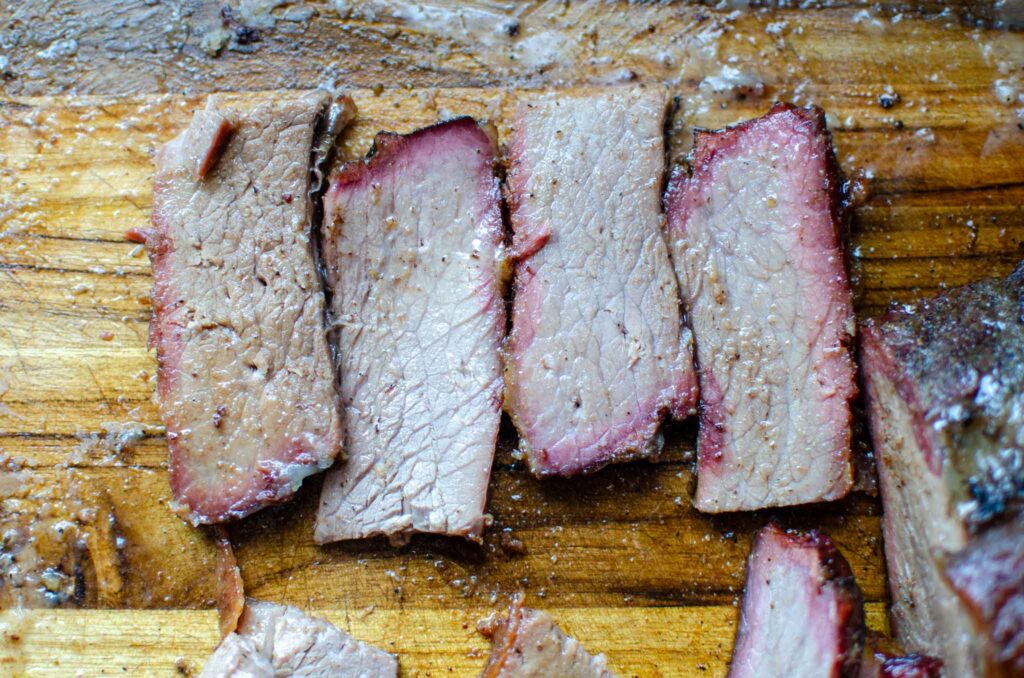
Point Brisket: Also known as the deckle, this cut has more fat running throughout the meat than the flat brisket and is triangular. This cut is perfect for shredding.
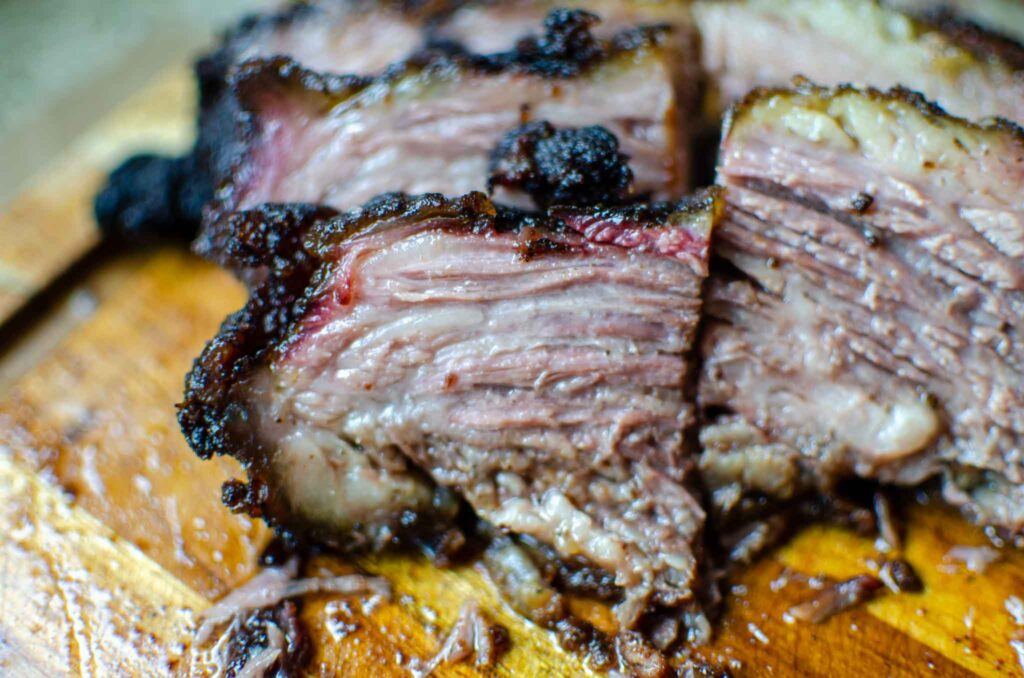
When picking a brisket, you want to look for uniform thickness so that it cooks evenly, roughly an inch or more thick. Any thinner than that and you run the risk of the meat drying out.
Equipment for Smoked Beef Brisket
Pellet Grill Smoker
A pellet grill smoker offers the capabilities of both a grill and a smoker and has a pellet hopper that dispenses the fuel as needed for an automated, consistent burn. Like all things, there is a range of features and price points available. Some things to consider when buying a pellet smoker are the capacity of the smoker, heat control and retention, and how well they are constructed.
With pellet grills being so widely available, smoking meats have become accessible to the masses. And for good reason. Traditional smoking requires maintaining a fire, oftentimes through the night. That is not the case with a pellet grill. You can set it and forget it.
Another important consideration is what features the smoker has, such as electric starters, wifi, grease management, an ash collector, and a pellet hopper. If you plan to use it more like a smoker, exploring ways to keep a consistent temperature and controlling smoke flow might be what’s important. If you plan to use it as a grill, creating heat zones might matter more.
We ultimately went with a Traeger because we knew with our large family, being able to smoke large quantities at one time mattered, and we were impressed with the quality of its construction. We’ve had it for 4 years now and still love it!
Wood Pellets
Wood pellets are made of compressed hardwood sawdust which allows them to fuel the smoker for a hot burn and a clean smoke. They come in many different kinds, resulting in many different flavors. Hickory is arguably the most used for its strong flavor, but it also complements many types of meats. I’d suggest staying away from Mesquite as the flavor is intense and can overpower your meat.
Whichever type of wood you decide, just be sure to use a high-quality pellet that’s produced from a name you trust. Pellet grills can experience challenges when used with lower-quality pellets as they produce excessive ash.
Temperature Probe
A temperature probe inserts into the meat and is left there to give a constant reading of the meat’s temperature, making it easier to know when to wrap the brisket or remove it from the smoker. Some temperature probes have Bluetooth capability, while others connect to the smoker.
Butcher paper
Butcher paper, sometimes referred to as peach paper, will help you get over the dreaded stall while keeping the bark intact.
Cooler
Use a clean, insulated cooler to let the brisket rest in and finish cooking. We like to line the bottom of the cooler with brown paper bags to help keep the cooler cleaner, otherwise towels would work too.
Sharp Knife and Cutting Board
You will need a large cutting board to slice the beef brisket, preferably one with a groove to catch all of the flavorful juices.
You’ve invested many hours up to this point in preparing the brisket, the final step is to slice it properly so you can enjoy it. Use a long, sharp carving knife to make clean brisket slices. The last thing you want to do is end up crushing or tearing the meat.
Smoked Beef Brisket Ingredients
- Whole packer brisket
- Apple cider vinegar
Dry Rub Ingredients
- Brown sugar
- salt
- Ground black pepper
- Garlic powder
- Onion powder
- cayenne (optional)
Smoked Beef Brisket Instructions
Prep
For best results prepare the brisket by removing some of the excess fat. Place the brisket on a flat, clean surface fat side down, and trim the hard fat chunk that is at the top of the point, where it meets the flat. It has a triangular shape. The silver skin is a thin membrane of connective tissue that gets tough and chewy when cooked, be sure to remove this too.


Flip the brisket over so that the fat side is facing up. Trim and remove some of the excess fat to create an even layer, leaving about an ¼ inch of fat. It doesn’t need to be perfect, so don’t fret too much about having it precise.
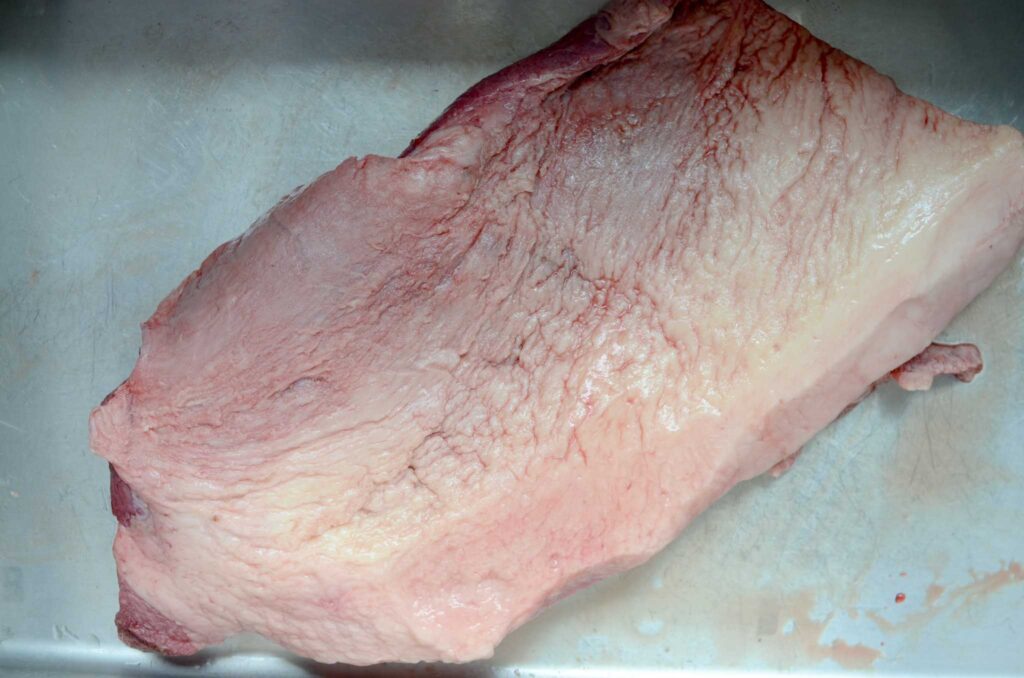
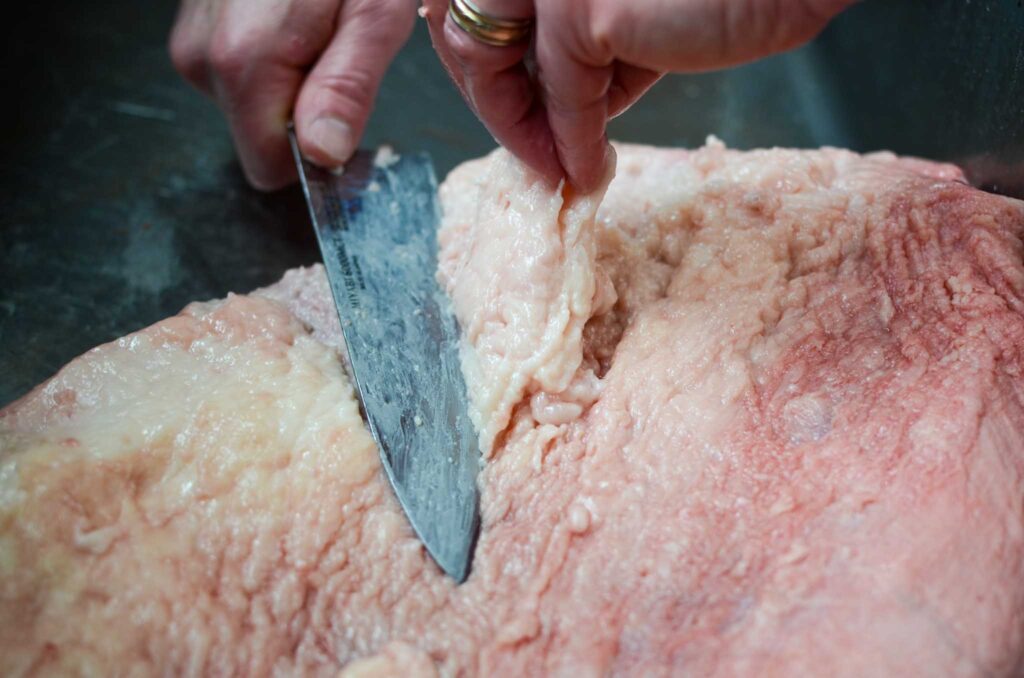
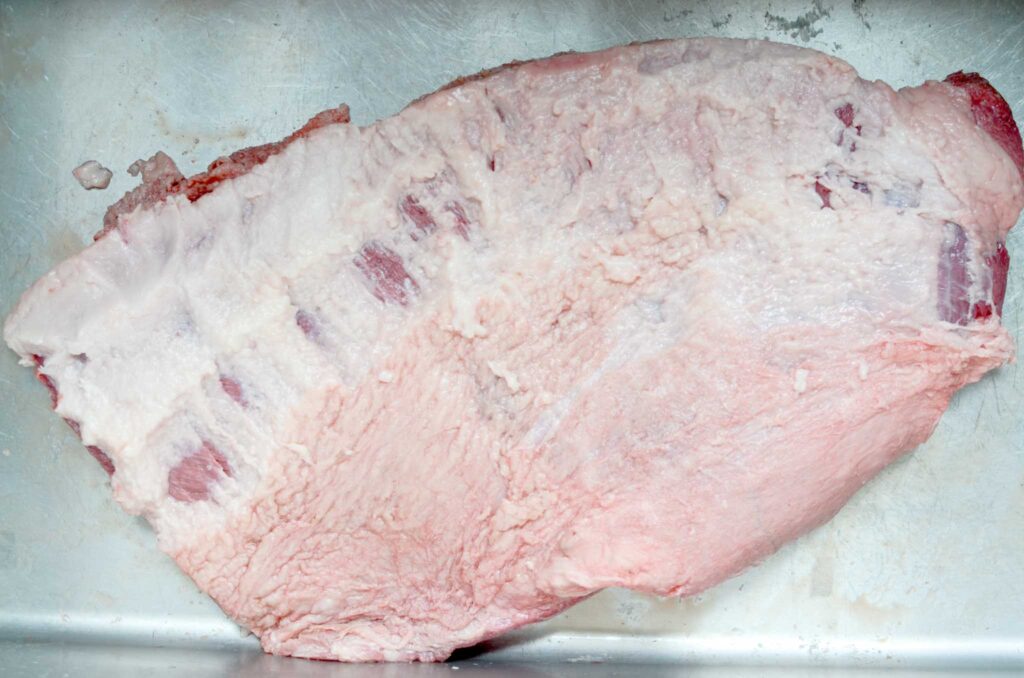
Dry Rub
Add salt, brown sugar, ground black pepper, onion powder, garlic powder, and cayenne to a small bowl and mix well to combine. The cayenne doesn’t add enough heat to make the brisket spicy, but if you’re sensitive to spice you can leave it out.
Optional: Lightly rub a binder, like yellow mustard or Dijon mustard, all over the brisket to make the seasoning stick to the surface. We add the rub straight onto the meat without a binder and have no issue with the rub sticking to the meat.
Apply the seasoning blend all over the trimmed brisket, including the sides of the brisket, pressing it into the meat so that it sticks. Cover the brisket with plastic wrap and place it in the refrigerator for 8-24 hours. The salt on the meat does the same thing that a brine does for a turkey, resulting in a flavorful, juicy meat.
Smoke
Set the grill to 225-250 degrees. Insert the temperature probe into the brisket and place the fat cap side up in the middle of the smoker. There are two options of how to handle the brisket while it’s on the smoker.
Option 1: Leave the beef brisket undisturbed in the smoker until the stall. The benefit of this method is that the meat comes up to temperature faster because you aren’t repeatedly opening the smoker. This would matter more in colder months.
Option 2 : Spray hourly with just enough apple cider vinegar to wet the surface of the meat as the beef brisket cooks until it reaches the stall. This will help to keep the brisket moist and also tenderize the meat.
We have done it both ways with great results, so it’s really up to personal preference.
When the internal temperature of the meat reaches the 150-165 degree mark, the meat will stall. Read below how to get past the stall.
To gauge how long your cut of meat will take to smoke, a general rule of thumb is an hour to an hour and 15 minutes a pound, not including time in the cooler. Note that your brisket isn’t be done to time, but to temperature.
Smoking the Beef Brisket Through the Stall
The stall is a temporary pause in the cooking process. When the brisket reaches the 150-165 degree mark, it will often sit at this temperature for a few hours. It may even drop in temperature and can last up to 4 hours. The stall has left many first-time smokers in a panic.
You can either wait out the stall until the temp eventually starts to rise again. But you run the risk of drying out your meat as the hot-cold temperatures battle to balance out, while losing some of the moisture as it evaporates.
The best way to overcome the stall is to wrap your meat. Wrapping a brisket in butcher paper is called “The Texas Crutch” and is used to speed up cooking, lock in moisture, and improve the bark appearance. Butcher paper allows the meat to breathe, keeping the bark intact. Foil holds in all of the moisture and steams the brisket, causing the brisket to lose its bark and have a pot roast texture.
Lay out two pieces of butcher paper, slightly overlapping in the middle. Lift the brisket into the middle of the butcher paper and wrap until the brisket is completely covered, tucking the ends of the paper under. Place the wrapped brisket back onto the smoker.
Why Does the Stall Happen?
There are many different speculations as to why this stall happens. Note that two things are happening at the same time the stall happens. First, the collagen proteins interact with moisture to create gelatin around the 160-degree mark. It also may be that the fat is rendering at this point, causing the temperature to stall.
The other reason for the stall could be from the juices that are starting to come out of the meat and evaporate. This moisture creates a vapor barrier and doesn’t allow heat to penetrate until the moisture is gone.
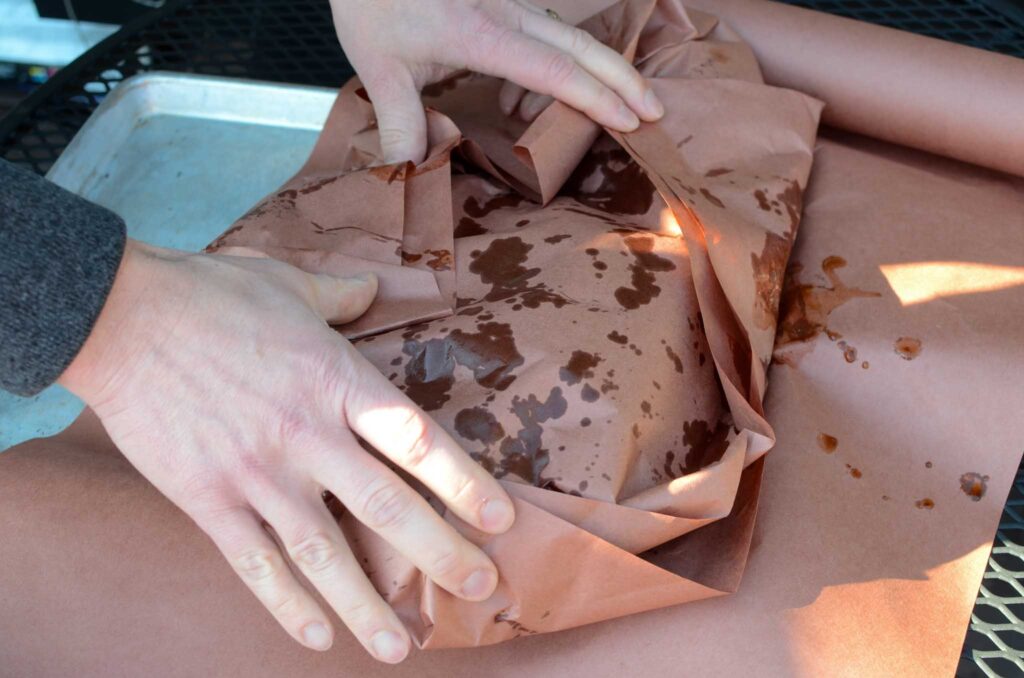
When It’s Done
Once the brisket reaches 195 degrees, we use these two tests to make sure that its done. First, unwrap the brisket from the butcher paper and give it a gentle shake, it will giggle like Jell-O when it’s ready. Second, when you probe the brisket with your finger or the end of a wooden spoon in a few different places, it should be like soft butter. If it’s not ready yet, the meat will feel tight and tough still when probed. Rewrap and place back onto the smoker for more time.
Cooler
When the beef brisket passes the tests, remove it from the smoker, rewrap it in the butcher paper and and place it in a cooler for at least an hour to finish cooking. This nice long rest completes the cooking process and brings the internal temperature up to 200 degrees.
Carve
How you want to eat the brisket determines how you want to cut it. If you are going traditional, slice the brisket into ¼-inch slices going against the grain. Pay attention to where the grain changes from the flat to the point if you plan to slice the whole brisket.
It’s easiest to start slicing the flat first (because it’s just one layer of muscle) and then rotate the meat and finish slicing with the point. A great option for the point is to make them into burnt ends. Just cut this section into chunks, toss in BBQ sauce, and place back on the smoker until the BBQ sauce has a nice crust on it.
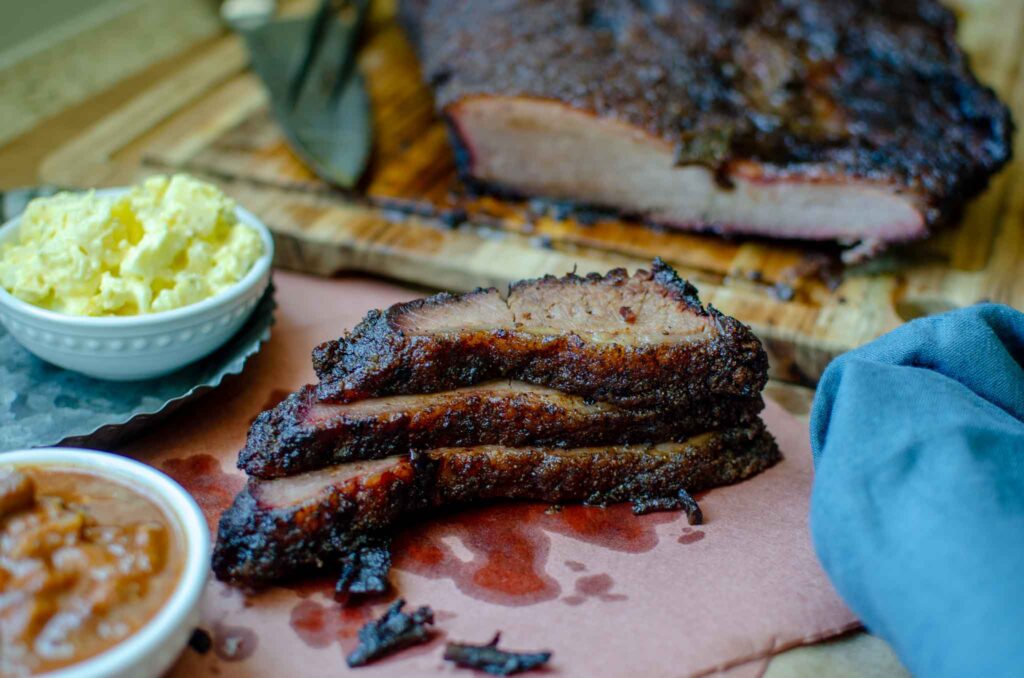
Storage
Smoked beef brisket is best the day it’s smoked. But with such a large piece of meat, you’ll sure to have leftovers. Store leftovers in an airtight container in the refrigerator for up to 3 days. To reheat, wrap the brisket in aluminum foil and and warm in a 325 degree oven until the meat is warmed through.
Some great ways to use leftover brisket is to make these delicious leftover brisket sandwiches or fried with eggs for a spectacular breakfast.
I’d love to hear from you! Please leave a comment and rate the recipe. Tag photos #Lockremhomestead over on Instagram when you share pictures of your Smoked Brisket!
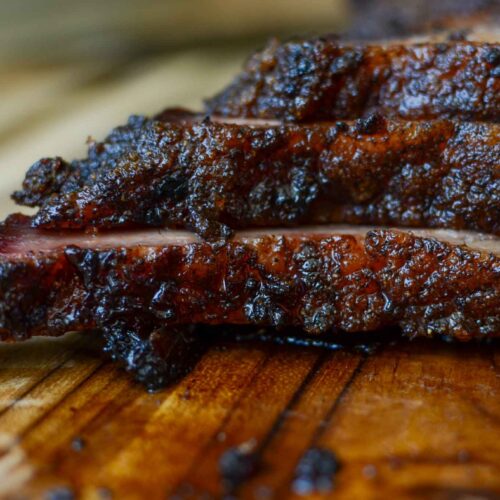
Perfect Smoked Beef Brisket Recipe using a Pellet Grill
Want to Save This Recipe?
Enter your email & I’ll send it to your inbox. Plus, get great new recipes from me every week!
By submitting this form, you consent to receive emails from Lockrem Homestead
Equipment
- 1 pellet grill
- wood pellets
- 1 temperature probe
- butcher paper
- 1 cooler
- 1 sharp knife
- 1 Cutting Board
Ingredients
- 10-15 lbs whole packer brisket
- ¼ cup salt
- 3 tbsp ground black pepper
- 1 cup brown sugar
- 2 tbsp garlic powder
- 2 tbsp onion powder
- 1 tsp cayenne powder
Instructions
Prep
- Place the brisket on a flat, clean surface with the fat side down and trim the hard fat chunk that is at the top of the point, where it meets the flat. It has a triangular shape.
- The silver skin is a thin membrane of connective tissue that gets tough and chewy when cooked, be sure to remove this too.
- Flip the brisket over so that the fat side is facing up. Trim and remove some of the excess fat to create an even layer, leaving about an ¼ inch of fat. It doesn't need to be perfect, so don't fret too much about having it precise.
Dry Rub
- Add salt, brown sugar, ground black pepper, onion powder, garlic powder, and cayenne to a small bowl and mix well to combine. The cayenne doesn't add enough heat to make the brisket spicy, but if you're sensitive to spice you can leave it out.
- Optional: Lightly rub a binder like yellow mustard or Dijon mustard all over the brisket to make the seasoning stick to the surface.
- Apply the seasoning blend over the entire brisket, including the sides, pressing it into the meat. Cover the brisket with plastic wrap and place it in the refrigerator for 8-24 hours, giving the seasoning plenty of time to flavor the meat.
Smoke
- Remove the brisket from the refridgerator 1 hour before smoking.
- Fill the hopper with wood pellets and set the grill to 225-250 degrees. Allow the grill to preheat for 15 minutes.
- Insert the temperature probe into the brisket and place the brisket fat side up in the middle of the smoker and close the lid.
- To gauge how long your cut of meat will take to smoke, a general rule of thumb is an hour to hour and 15 minutes a pound, not including time in the cooler. But know that your brisket won’t be done to time, but to temperature. Option 1: Leave the beef brisket undisturbed in the smoker until the stall. The benefit of this method is that the meat comes up to temperature faster because you aren't repeatedly opening the smoker. This would matter more in colder months.Option 2 : Spray hourly with just enough apple cider vinegar to wet the surface of the meat as the beef brisket cooks until it reaches the stall. This will help to keep the brisket moist and also tenderize the meat.We have done it both ways with great results.
- When the internal temperature reaches the 150-165 degree mark, the meat will stall. Read below how to get past the stall.
Smoking Through the Stall
- The best way to overcome the stall is to wrap your meat. Wrapping a brisket in butcher paper is called "The Texas Crutch" and is used to speed up cooking, lock in moisture, and improve the bark appearance. Butcher paper allows the meat to breathe, keeping the bark intact. Foil holds in all of the moisture and steams the brisket, causing the brisket to lose its bark and have a pot roast texture.
- Lay out two pieces of butcher paper, slightly overlapping in the middle. Lift the brisket into the middle of the butcher paper and wrap until the brisket is completely covered, tucking the ends of the paper under.
When It's Done
- Once the brisket reaches 195 degrees, we use these two tests to make sure that its done.
- First, unwrap the brisket from the butcher paper and give it a gentle shake, it will giggle like Jell-O when it's ready.
- Second, when you probe the brisket with your finger or the end of a wooden spoon in a few different places, it should be like soft butter. If it's not ready yet, the meat will feel tight and tough still when probed. Rewrap and place back onto the smoker for more time.
Cooler
- When the beef brisket has passed the tests, remove it from the smoker and place the wrapped brisket in a cooler for at least an hour to finish cooking. This nice long rest completes the cooking process and brings the internal temperature up to 200 degrees.
Carve
- How you want to eat the brisket determines how you want to cut it. If you are going traditional, slice the brisket into ¼-inch slices, going against the grain. Pay attention to where the grain changes from the flat to the point if you plan to slice the whole brisket.
- It's easiest to start slicing the flat first (because it’s just one layer of muscle) and then rotate the meat and finish slicing with the point. A great option for the point is to make them into burnt ends. Just cut this section into chunks, toss in BBQ sauce, and place back on the smoker until the BBQ sauce has a nice crust on it.
Storage
- Smoked beef brisket is best the day it's smoked. But with such a large piece of meat, you'll sure to have leftovers. Store leftovers in an airtight container in the refrigerator for up to 3 days. To reheat, wrap the brisket in aluminum foil and and warm in a 325 degree oven until the meat is warmed through.

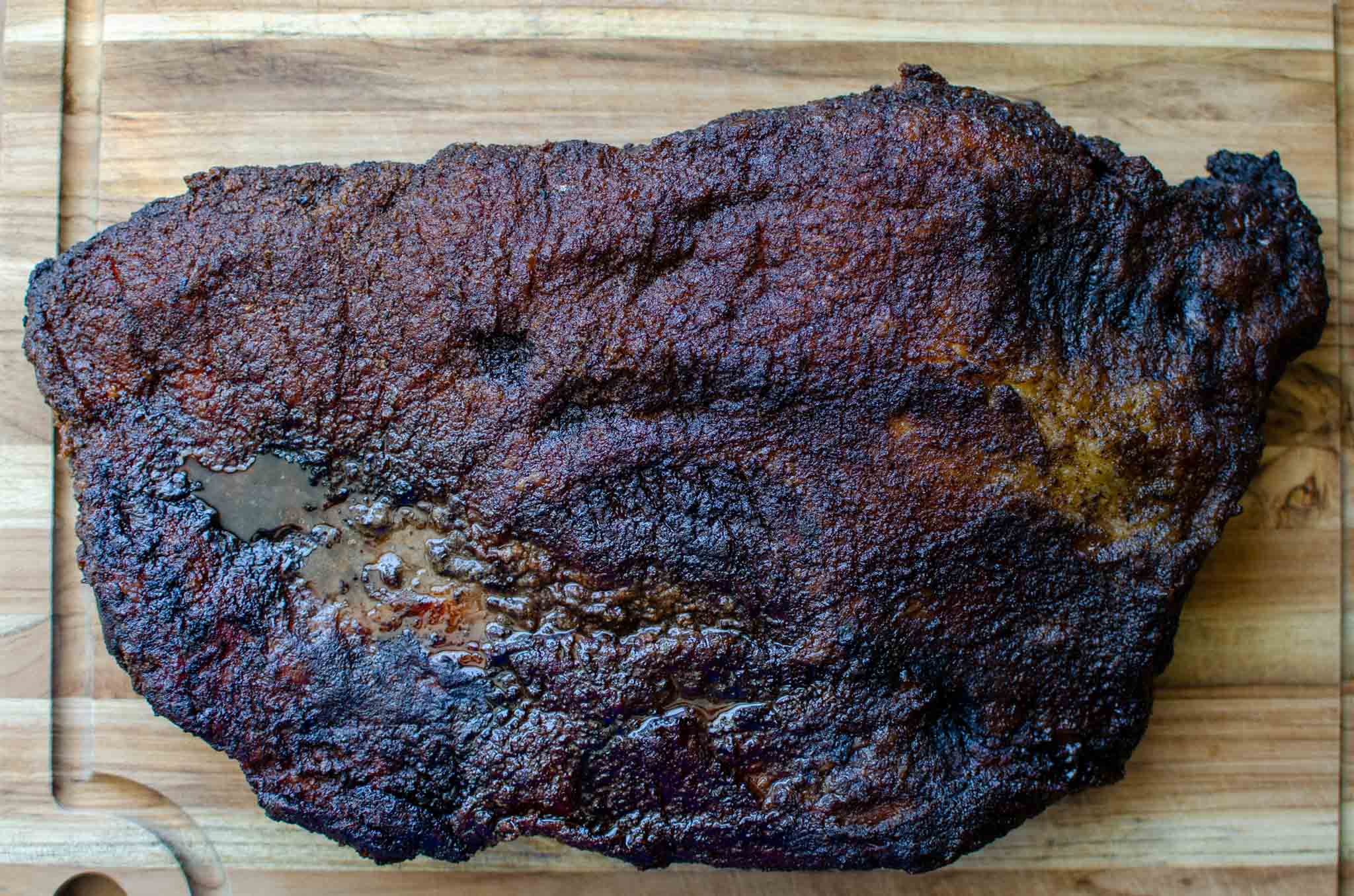

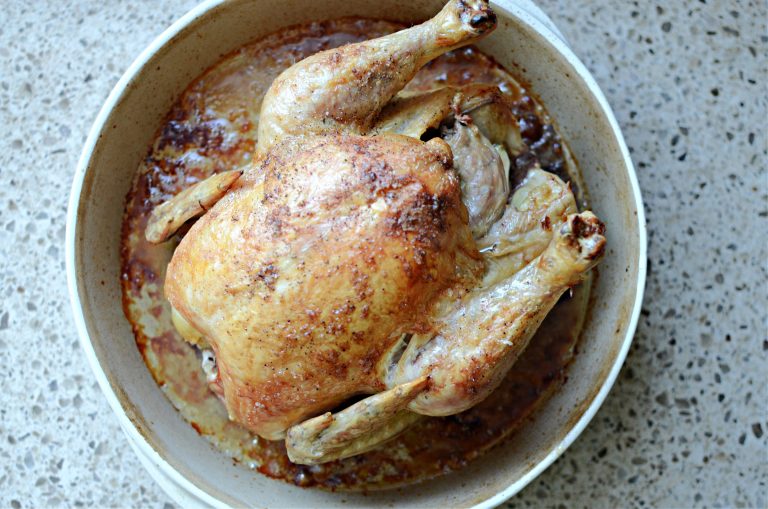
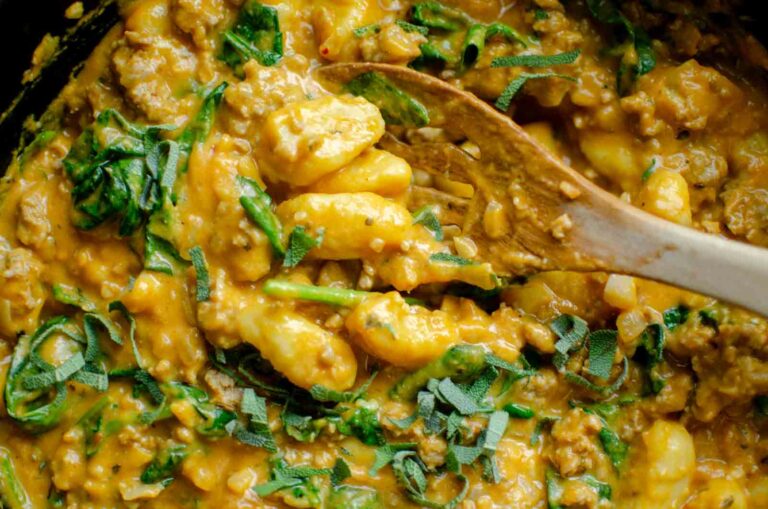
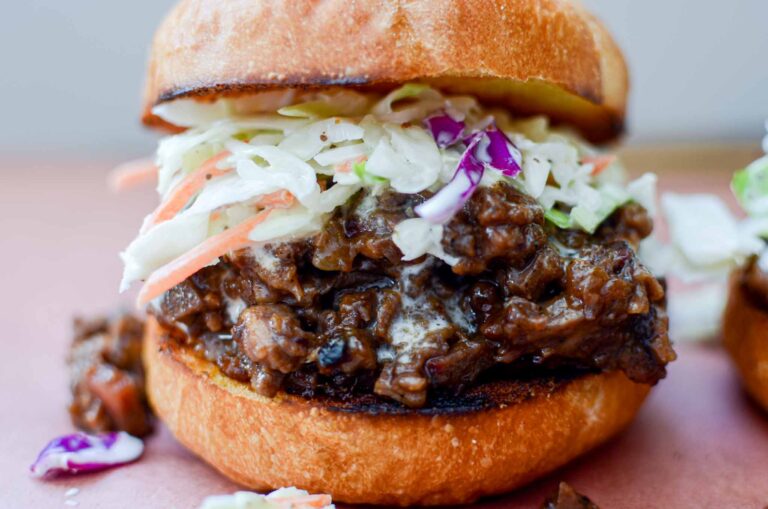
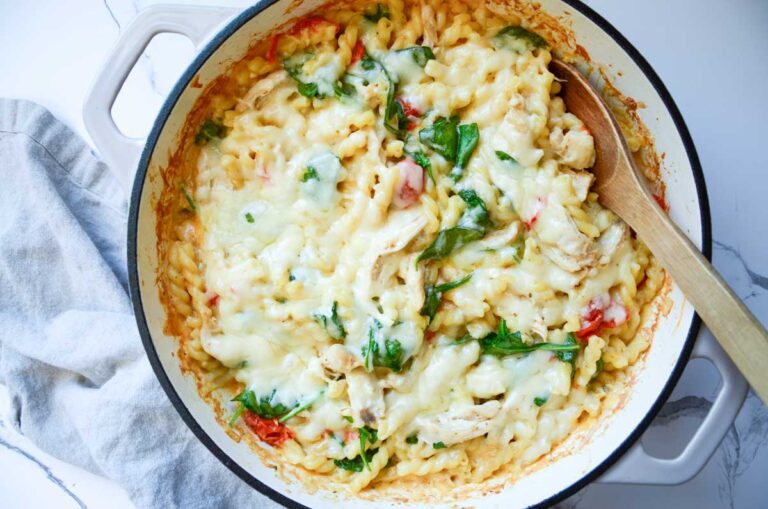
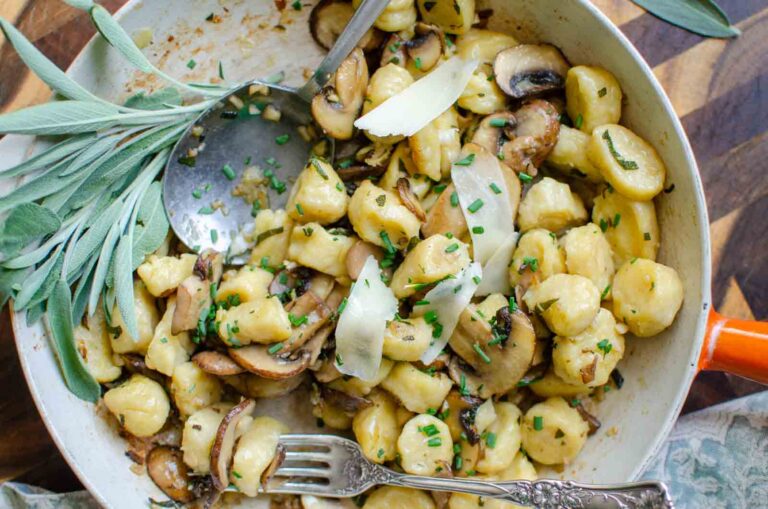
I know you’re going to LOVE this recipe! It’s one of our family favorites. Plus, don’t forget that you can leave a comment or ask me a question here, and I’ll get back to you!